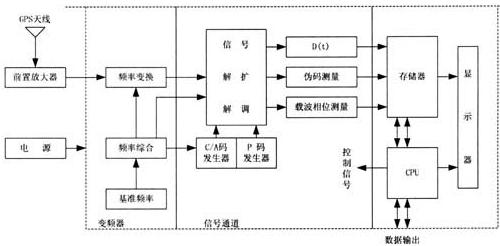
Privacy statement: Your privacy is very important to Us. Our company promises not to disclose your personal information to any external company with out your explicit permission.
GPS receiver schematic

GPS Receiver Schematic Overview
Antenna
GPS receiver receives signals from GPS satellites through antennas. The antenna is responsible for capturing weak satellite signals.
RF Front-end
Converts the radio frequency (RF) signal captured by the antenna to an intermediate frequency (IF) or baseband signal.
May contain a low noise amplifier (LNA) to increase signal strength, and filters to reduce interference.
Digital Signal Processor (DSP)
Digitizes the intermediate frequency or baseband signal.
Performs necessary signal processing and calculations to extract navigation data from the received signal.
Navigation Processor
Calculates the precise position, velocity, and time (PVT) of the receiver using signals and navigation data received from multiple satellites.
At least 4 satellite signals are usually required for three-dimensional positioning.
Output and Interfaces
Converts the calculation results into a format that the user can understand, such as latitude and longitude, altitude, etc.
Provides interfaces with other devices or systems, such as the NMEA 0183 standard interface for communication with systems such as ship navigation and vehicle navigation.
Power Management
Responsible for providing stable power to all parts of the receiver.
May include battery-powered options for use without an external power source.
Control and User Interface
Allows the user to configure the parameters and settings of the receiver.
Displays the status, location, and other relevant information of the receiver.
Key Components and Functions
LNA (Low Noise Amplifier): Improves the strength of the signal captured by the antenna and reduces noise interference.
DSP (Digital Signal Processor): Converts analog signals to digital signals for signal processing and calculation.
NMEA 0183 standard: A widely used GPS receiver data output format that allows communication and data exchange between different devices.
Multi-channel reception: GPS receivers can receive signals from multiple satellites at the same time to improve positioning accuracy and reliability.
Dual-frequency reception: Some advanced GPS receivers can receive signals from both L1 and L2 frequencies at the same time to eliminate the impact of the ionosphere on the signal and improve positioning accuracy.
Wifi Antenna, Router Antenna, Patch Antenna
November 16, 2024
September 18, 2023
June 28, 2024
June 28, 2024
이 업체에게 이메일로 보내기
November 16, 2024
September 18, 2023
June 28, 2024
June 28, 2024

Privacy statement: Your privacy is very important to Us. Our company promises not to disclose your personal information to any external company with out your explicit permission.

Fill in more information so that we can get in touch with you faster
Privacy statement: Your privacy is very important to Us. Our company promises not to disclose your personal information to any external company with out your explicit permission.